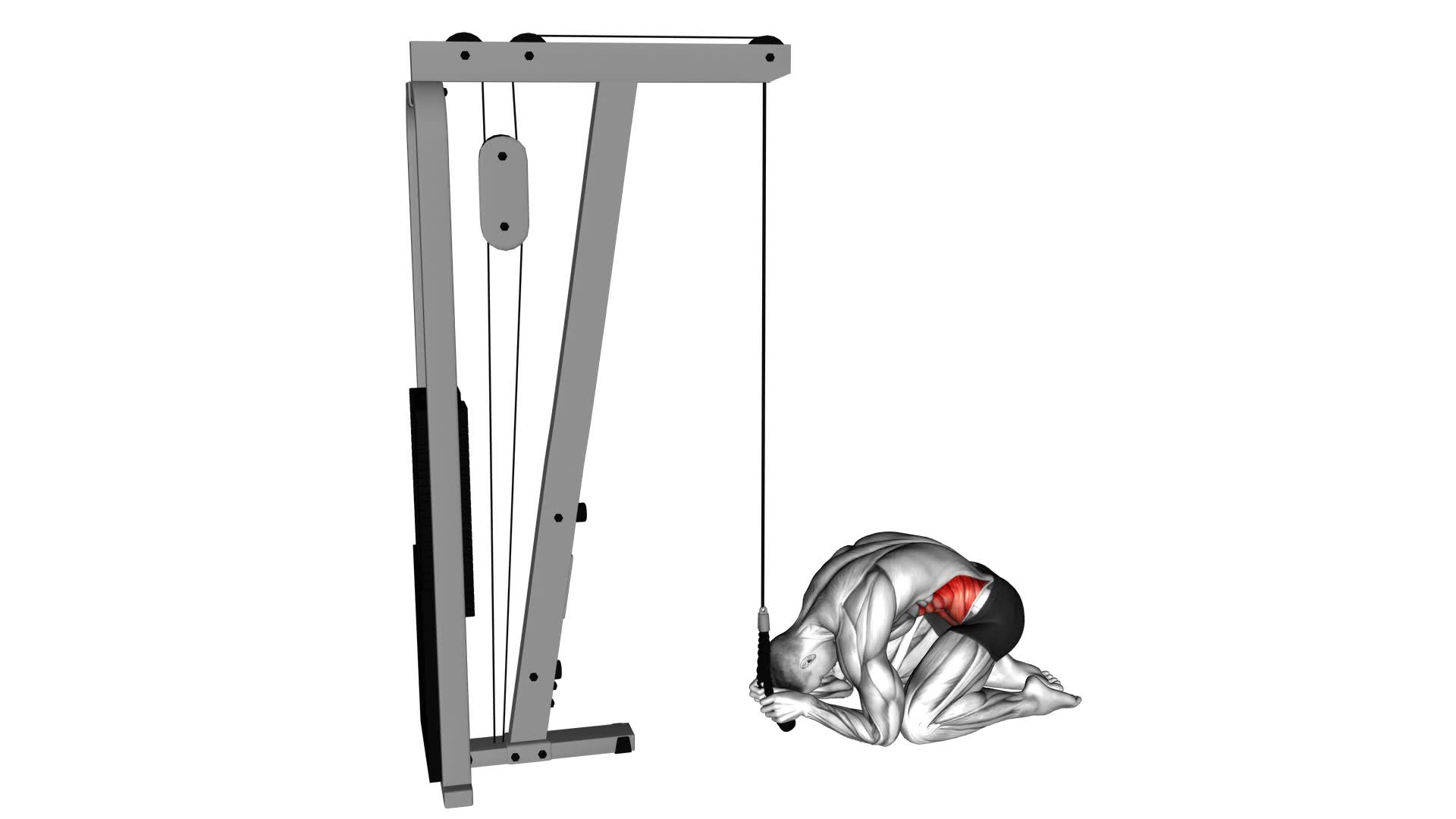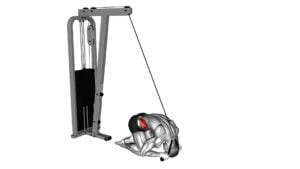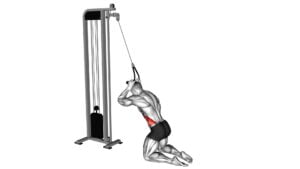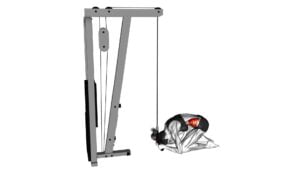Cable Kneeling Crunch – Video Exercise Guide & Tips

Get ready to tone your abs with the cable kneeling crunch! This video exercise guide will show you the proper form and technique to maximize your results.
Watch This Exercise Video
Set up the equipment and get ready to feel the burn. With variations and progressions, you can challenge yourself as you get stronger.
Avoid common mistakes and follow these tips to achieve a stronger core.
Let's get started!
Key Takeaways
- Cable kneeling crunch targets abdominal muscles, obliques, and lower back muscles.
- Proper form and technique are crucial for maximum effectiveness and to minimize the risk of injury.
- Engaging core muscles by activating them and focusing on abdominal muscles is essential.
- Variations, progressions, and avoiding common mistakes can improve core strength and stability.
Benefits of Cable Kneeling Crunch
You can maximize your core strength and stability with the cable kneeling crunch. This exercise is a great way to target your abdominal muscles and improve your overall core strength. The cable kneeling crunch offers a variety of modifications to suit your fitness level and goals.
One modification you can try is adjusting the weight on the cable machine. Start with a lighter weight and gradually increase it as you become more comfortable with the exercise. Another modification is to change the position of your hands. You can place your hands behind your head or across your chest to increase or decrease the intensity of the exercise.
The cable kneeling crunch is just one of many core strengthening exercises you can incorporate into your workout routine. It targets not only your abs but also your obliques and lower back muscles. By regularly performing this exercise, you can improve your posture, stability, and overall core strength.
Remember to always engage your core and maintain proper form throughout the exercise. Keep your back straight, shoulders relaxed, and exhale as you crunch forward. With consistency and proper technique, the cable kneeling crunch can help you achieve a stronger and more stable core.
Proper Form and Technique
To perform the cable kneeling crunch with proper form and technique, there are several key points to keep in mind.
First, focus on maintaining correct spinal alignment throughout the exercise to protect your back and neck.
Engage your core muscles by actively contracting them, rather than relying on momentum to complete the movement.
Correct Spinal Alignment
Maintain proper spinal alignment throughout the Cable Kneeling Crunch exercise to maximize its effectiveness and minimize the risk of injury. Correct spinal alignment is crucial for improving posture and preventing back pain. Here are some key points to remember:
- Keep your back straight and aligned with your neck throughout the exercise.
- Avoid rounding or arching your back, as this can strain your spine.
- Engage your core muscles to support your spine and maintain stability.
- Keep your shoulders relaxed and down, away from your ears.
- Remember to breathe properly, inhaling as you lower and exhaling as you crunch.
By maintaining correct spinal alignment, you won't only optimize the benefits of the Cable Kneeling Crunch but also protect your back from unnecessary strain.
Now, let's move on to the next section and learn how to engage your core muscles effectively.
Engage Core Muscles
To effectively engage your core muscles during the Cable Kneeling Crunch, focus on activating your abdominal muscles. Core activation is crucial for proper form and technique in this exercise. By consciously contracting your abs, you can strengthen your core and maximize the benefits of this workout.
As you perform the crunch, imagine pulling your belly button towards your spine, engaging your deep abdominal muscles. This will help stabilize your spine and protect your lower back. Remember to breathe steadily throughout the movement, exhaling as you crunch and inhaling as you return to the starting position.
Engaging your core muscles won't only improve your strength but also enhance your overall stability.
Now, let's move on to the next section and learn how to avoid excessive momentum during the Cable Kneeling Crunch.
Avoid Excessive Momentum
Now, let's focus on how you can avoid excessive momentum and maintain proper form and technique during the Cable Kneeling Crunch.
To improve stability and get the most out of this exercise, it's important to use controlled movements. Here are some tips to help you achieve this:
- Start with a weight that challenges you, but still allows you to maintain control throughout the movement.
- Engage your core muscles and keep them activated throughout the exercise to stabilize your body.
- Avoid using your arms to pull or swing the cable, as this can create momentum and take away from the effectiveness of the exercise.
- Focus on the contraction of your abdominal muscles as you crunch forward, rather than relying on momentum to bring you up.
- Slowly return to the starting position, maintaining control and resisting the urge to let the weight pull you back.
Equipment and Set Up
To properly execute the cable kneeling crunch, you'll need a cable machine or dumbbells. The cable machine should be set at a height where you can comfortably grasp the handles.
When using dumbbells, make sure to choose a weight that challenges you without compromising form. Keep these equipment and set up tips in mind to maximize the effectiveness of your exercise.
Cable or Dumbbells
To set up the cable or dumbbells for the kneeling crunch exercise, you'll need a cable machine or a pair of dumbbells.
Here is a bullet list of things to consider when deciding between cable exercises and dumbbell exercises:
- Range of Motion: Cables allow for a greater range of motion, making it easier to target specific muscles.
- Stability: Dumbbells require more stability and control, engaging the core and secondary muscles.
- Variety: Cables offer a wide range of exercises and variations, targeting different muscle groups.
- Resistance: Dumbbells provide constant resistance throughout the movement, challenging muscles evenly.
- Space and Equipment: Cables require a cable machine, while dumbbells are more versatile and can be used anywhere.
Consider your goals, available equipment, and personal preferences when choosing between cable exercises and dumbbell exercises for the kneeling crunch.
Proper Form Tips
Ensure proper form and set up for the cable kneeling crunch exercise to maximize its effectiveness.
To avoid injury, make sure the cable machine is securely anchored and the weight is appropriate for your fitness level.
Attach a rope handle to the high pulley of the cable machine and adjust the height so that it's slightly above your head.
Position yourself on your knees facing away from the machine, grasping the rope handles with your hands crossed over your chest.
Keep your core engaged and maintain a neutral spine as you begin the exercise.
To modify or regress the exercise, you can decrease the weight or use a stability ball for support.
Now, let's move on to the next section to explore variations and progressions of the cable kneeling crunch.
Variations and Progressions
Once you have mastered the basic cable kneeling crunch, you can further challenge yourself by incorporating variations and progressions into your workout routine.
- Weighted Cable Kneeling Crunch: Add additional weight by holding a dumbbell or a weight plate against your chest while performing the exercise. This will increase the resistance and intensity of the movement, helping you build stronger core muscles.
- Oblique Cable Kneeling Crunch: Instead of performing the crunch straight forward, twist your torso to either side as you bring your elbows towards your knees. This targets the oblique muscles on the sides of your waist, giving you a more defined and sculpted midsection.
- Single-Arm Cable Kneeling Crunch: Perform the exercise using only one arm at a time. This variation requires greater stability and control, engaging your core muscles even more.
- Cable Kneeling Crunch with Knee Raise: As you crunch forward, simultaneously lift one knee towards your chest. This adds an element of balance and coordination to the exercise, as well as targeting your hip flexors.
- Cable Kneeling Crunch with Twist: Perform a regular cable kneeling crunch, but as you crunch forward, twist your torso to one side. Alternate sides with each repetition to engage your obliques and challenge your core stability.
Incorporating these variations and progressions into your cable kneeling crunch routine will help you continue to improve your core strength and stability, and keep your workouts challenging and effective. Remember to always maintain proper form and listen to your body to prevent injuries.
Common Mistakes to Avoid
One common mistake to avoid during the cable kneeling crunch is improper form. Proper technique is crucial for maximizing the effectiveness of this exercise and minimizing the risk of injury.
One common mistake isn't maintaining a neutral spine throughout the movement. It's important to keep your back straight and avoid excessive rounding or arching.
Another common mistake is using momentum to perform the exercise instead of relying on your abdominal muscles. Remember to engage your core and control the movement with a slow and controlled tempo.
Additionally, many people make the mistake of not fully extending their torso at the top of the movement. Make sure to squeeze your abs and fully contract them at the top position.
Lastly, it's important to use an appropriate weight that challenges your muscles without sacrificing proper form. Start with a lighter weight and gradually increase as you become stronger and more comfortable with the exercise.
Tips for Maximizing Results
To maximize your results, focus on engaging your core and maintaining proper form throughout the cable kneeling crunch exercise. By following these tips, you can ensure that you're maximizing efficiency and targeting specific muscle engagement:
- Slow and controlled movements: Avoid rushing through the exercise. Instead, focus on performing slow and controlled movements to fully engage your core muscles.
- Squeeze at the top: When you crunch forward, make sure to squeeze your abs at the top of the movement. This will help to intensify the contraction and maximize muscle engagement.
- Maintain a neutral spine: Keep your spine in a neutral position throughout the exercise. Avoid arching or rounding your back, as this can put unnecessary strain on your spine and decrease the effectiveness of the exercise.
- Breathe properly: Remember to exhale as you crunch forward and inhale as you return to the starting position. Proper breathing technique can help to enhance your core engagement and overall performance.
- Gradually increase resistance: As you become stronger, gradually increase the resistance on the cable machine. This will challenge your muscles and promote continuous progress.
Frequently Asked Questions
How Many Calories Can I Burn by Doing Cable Kneeling Crunches?
If you're wondering how many calories you can burn by doing cable kneeling crunches, it's important to note that the number of calories burned during exercise varies based on factors such as weight, intensity, and duration.
However, cable kneeling crunches are a great way to engage your core muscles and burn calories.
If you're looking for alternative equipment, you can consider using resistance bands or medicine balls to add variety to your workout routine.
Can I Do Cable Kneeling Crunches if I Have Lower Back Pain?
If you're experiencing lower back pain, it's important to modify your cable kneeling crunches to avoid further discomfort.
Instead, try alternative exercises that won't strain your lower back.
Plank variations, such as the forearm plank or side plank, can engage your core without putting excessive pressure on your lower back.
Additionally, exercises like bird dogs or glute bridges can help strengthen your core and alleviate lower back pain.
Prioritize your comfort and choose exercises that work best for you.
Is It Necessary to Use a Cable Machine for This Exercise, or Can I Use Other Equipment?
You can definitely use other equipment for kneeling crunches instead of a cable machine. There are alternative options like resistance bands or a stability ball that can provide similar benefits.
These modifications can help you target your core muscles effectively without putting additional strain on your lower back. It's important to choose the equipment that feels comfortable and allows you to maintain proper form throughout the exercise.
Can I Perform Cable Kneeling Crunches if I Am a Beginner?
Yes, you can definitely perform cable kneeling crunches if you're a beginner. This exercise can be modified to suit your fitness level by adjusting the weight and resistance on the cable machine.
Cable kneeling crunches are great for beginners because they target your core muscles and help strengthen your abs. They also improve your overall stability and balance.
Incorporating this exercise into your routine will provide you with a solid foundation for more advanced movements.
How Often Should I Incorporate Cable Kneeling Crunches Into My Workout Routine for Optimal Results?
To achieve optimal results, incorporate cable kneeling crunches into your workout routine consistently. By regularly incorporating this exercise, you can effectively target your core muscles and improve their strength and definition.
It's recommended to perform cable kneeling crunches at least 2-3 times a week. Remember to start with lighter weights and gradually increase the resistance as you become more comfortable and experienced.
Always listen to your body and consult a professional if you have any concerns.
Conclusion
In conclusion, the cable kneeling crunch is a highly effective exercise for strengthening and toning the core muscles. By maintaining proper form and technique, using the right equipment, and avoiding common mistakes, you can maximize your results and reap the benefits of this exercise.
Remember to vary your workouts and challenge yourself with different variations and progressions to continue seeing progress. Stay consistent and dedicated to achieve your fitness goals.

Author
Years ago, the spark of my life’s passion ignited in my mind the moment I stepped into the local gym for the first time. The inaugural bead of perspiration, the initial endeavor, the very first surge of endorphins, and a sense of pride that washed over me post-workout marked the beginning of my deep-seated interest in strength sports, fitness, and sports nutrition. This very curiosity blossomed rapidly into a profound fascination, propelling me to earn a Master’s degree in Physical Education from the Academy of Physical Education in Krakow, followed by a Sports Manager diploma from the Jagiellonian University. My journey of growth led me to gain more specialized qualifications, such as being a certified personal trainer with a focus on sports dietetics, a lifeguard, and an instructor for wellness and corrective gymnastics. Theoretical knowledge paired seamlessly with practical experience, reinforcing my belief that the transformation of individuals under my guidance was also a reflection of my personal growth. This belief holds true even today. Each day, I strive to push the boundaries and explore new realms. These realms gently elevate me to greater heights. The unique combination of passion for my field and the continuous quest for growth fuels my drive to break new ground.







